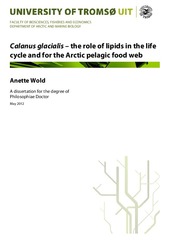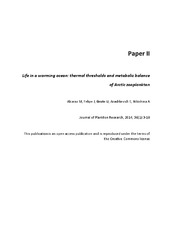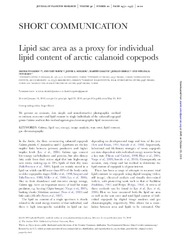Blar i tittel Fakultet for biovitenskap, fiskeri og økonomi
Viser treff 545-564 av 5064
-
Cage fish farming for the livelihood improvement of the local people in Kulekhani, Nepal
(Master thesis; Mastergradsoppgave, 2022-05-15)In Nepal, cage fish culture in the lake and reservoir has plays important role in the improvement of the livelihood of local people through creating employment, improving incomes, and assuring food security. Cage fish farming in Kulekhani was implemented with the support of the International Development Research Centre, Canada (IDRC) and the Nepal government to improve the livelihood of those people ... -
CALANGO: A phylogeny-aware comparative genomics tool for discovering quantitative genotype-phenotype associations across species
(Journal article; Tidsskriftartikkel; Peer reviewed, 2023-06-09)Living species vary significantly in phenotype and genomic content. Sophisticated statistical methods linking genes with phenotypes within a species have led to breakthroughs in complex genetic diseases and genetic breeding. Despite the abundance of genomic and phenotypic data available for thousands of species, finding genotype-phenotype associations across species is challenging due to the ... -
Calanus glacialis : the role of lipids in the life cycle and for the Arctic pelagic food web
(Doctoral thesis; Doktorgradsavhandling, 2012-05-23)The Arctic marine ecosystem is characterized by strong seasonality and a short but productive period of primary production in the spring when the ice breaks up. Calanus glacialis is one of the key links between primary producers and higher trophic levels, and it is adapted to the strong seasonality by life cycle traits such as; seasonal vertical migration, diapausing, reproduction in the spring and ... -
Calanus glacialis and C. finmarchicus in a warming Arctic Implications of increasing temperature at the individual and population level
(Doctoral thesis; Doktorgradsavhandling, 2017-03-21)Climate change is particularly pronounced in the Arctic and water temperatures are predicted to increase substantially. This has important implications for Arctic marine organism, especially ectotherms, such as copepods. The calanoid copepods Calanus glacialis and C. finmarchicus are key species of different pelagic food webs at high latitudes and changes in temperature will likely affect them ... -
Calanus oil and its constituents as a therapeutic approach to target obesity-induced metabolic distortions
(Doctoral thesis; Doktorgradsavhandling, 2023-11-24)Obesity is one of the leading causes for the development of metabolic disorders, such as insulin resistance and type 2 diabetes. Omega-3 fatty acids, found in seafood and marine oils, are shown to reduce obesity, lower blood lipid levels, change the composition of the gut microbiota and reduce the risk for cardiovascular diseases. The increased demand for seafood and marine oils has put pressure on ... -
Calanus spp. in the Arctic ecosystem - a story on predation, distribution and methodology
(Doctoral thesis; Doktorgradsavhandling, 2014-11-19)The calanoid copepods of the genus Calanus (C. finmarchicus, C. glacialis and C. hyperboreus) are key elements in the Arctic ecosystem. They link primary producers (ice algae, phytoplankton) and higher trophic levels through their ability to convert low energy carbohydrates and proteins to high energy wax esters. This energy is stored in a separate and conspicuous lipid sac. This ability to store ... -
Calanus® Oil. Utilization, composition and digestion
(Doctoral thesis; Doktorgradsavhandling, 2016-07-03)In the pelagic system, phytoplankton are the main producers of n-3 LC-PUFA and make up the foundation of the oceanic food web. Zooplankton, such as copepods and krill, are the most numerous primary consumers in the marine environment and have a central role in the energy transfer to higher trophic levels. The copepod Calanus finmarchicus is present in large amounts in the North Atlantic and has ... -
Caligus elongatus and other sea lice of the genus Caligus as parasites of farmed salmonids: A review
(Journal article; Tidsskriftartikkel; Peer reviewed, 2020-02-24)This review was prompted by reports of unusually large numbers of sea lice tentatively identified as <i>Caligus elongatus</i> infesting farmed salmon in northern Norway. Following a brief introduction to the sea lice problem in salmonid aquaculture, the review is divided into a further eight sections. The first is a review of existing information on the life cycle and behaviour of <i>Caligus</i> ... -
Calving rates at tidewater glaciers vary strongly with ocean temperature
(Journal article; Tidsskriftartikkel; Peer reviewed, 2015-10-09)Rates of ice mass loss at the calving margins of tidewater glaciers (frontal ablation rates) are a key uncertainty in sea level rise projections. Measurements are difficult because mass lost is replaced by ice flow at variable rates, and frontal ablation incorporates sub-aerial calving, and submarine melt and calving. Here we derive frontal ablation rates for three dynamically contrasting glaciers ... -
Calving site characteristics and habitat use in Svalbard reindeer
(Master thesis; Mastergradsoppgave, 2018-05-15)Migrating reindeer and caribou tend to return to traditional calving locations every spring with specific environmental conditions and protection of calving grounds is a central part of Rangifer conservation. In contrast, the non-migratory Svalbard reindeer inhabit an environment free of predators during calving season making them ideal as a reference population. Little is known about habitat ... -
Can a key boreal Calanus copepod species now complete its life-cycle in the Arctic? Evidence and implications for Arctic food-webs
(Journal article; Tidsskriftartikkel; Peer reviewed, 2021-11-29)The changing Arctic environment is affecting zooplankton that support its abundant wildlife. We examined how these changes are influencing a key zooplankton species, Calanus finmarchicus, principally found in the North Atlantic but expatriated to the Arctic. Close to the ice-edge in the Fram Strait, we identified areas that, since the 1980s, are increasingly favourable to C. finmarchicus. Field-sampling ... -
Can a large-mesh sieve panel replace or supplement the Nordmøre grid for bycatch mitigation in the northeast Atlantic deep-water shrimp fishery?
(Journal article; Tidsskriftartikkel; Peer reviewed, 2019-07-26)The Nordmøre grid is the principle bycatch mitigation device in many shrimp trawl fisheries. However, in several of these fisheries, bycatch is a problem because small sized fish can pass through the grid and enter the codend together with the targeted shrimp. One such fishery is the Northeast Atlantic deep-water shrimp (<i>Pandalus borealis</i>) fishery, where the use of a Nordmøre grid is mandatory. ... -
Can a piscicide treatment alter stream ecosystem functioning through trophic cascading effects on benthic invertebrates?
(Master thesis; Mastergradsoppgave, 2021-05-18)Processing of detritus is an important ecosystem function in freshwaters. In rivers and streams, the activity of shredding invertebrates play an important role in processing of coarse-particulate organic matter such as leaf litter. In stream food webs, fish may act as top predators and control activity of consumers such as shredders top down. This top-down effect may be of a directly consumptive nature, ... -
Can aquaculture impact the surrounding biodiversity? A metabarcoding assessment
(Master thesis; Mastergradsoppgave, 2020-06-01)World’s population growth and rise in food consumption per capita have led to increased food demand and overexploitation of natural resources in recent decades. Such increase has threatened the global feeding schemes to maintain a balance between food supply and demand. Although “The Blue Revolution” promised to fill such gap and simultaneously alleviate the overexploitation of the oceans, deterioration ... -
Can baleen whales be safely live-captured for studies of their physiology?
(Master thesis; Mastergradsoppgave, 2022-05-16)Studying baleen whales is challenging and complex, where observation of their habitat, sensory modalities, behavior and physiology, are infrequent and brief. The biochemical and biophysical contribution of mysticetes serve a vital role in maintaining a healthy marine ecosystem, but they are facing anthropogenic threats. Before giving any indications of how these threats affect the baleen whales, it ... -
Can biodegradable materials reduce plastic pollution without decreasing catch efficiency in longline fishery?
(Journal article; Tidsskriftartikkel; Peer reviewed, 2022-03-23)Longlining is a widely used fishing method. During longline fishing, some of the snoods connecting the hooks to the mainline are often lost at sea. Since snoods are made of nylon or polyester, lost snoods contribute to marine plastic pollution. Replacing nylon or polyester with a new material made of biodegradable plastics can potentially reduce macro- and microplastic pollution that is caused by ... -
Can bryophyte groups increase functional resolution in tundra ecosystems?
(Journal article; Tidsskriftartikkel; Peer reviewed, 2021-08-30)The relative contribution of bryophytes to plant diversity, primary productivity, and ecosystem functioning increases towards colder climates. Bryophytes respond to environmental changes at the species level, but because bryophyte species are relatively difficult to identify, they are often lumped into one functional group. Consequently, bryophyte function remains poorly resolved. Here, we explore ... -
Can bryophyte groups increase functional resolution in tundra ecosystems?
(Journal article; Tidsskriftartikkel; Peer reviewed, 2021-08-30)The relative contribution of bryophytes to plant diversity, primary productivity, and ecosystem functioning increases towards colder climates. Bryophytes respond to environmental changes at the species level, but because bryophyte species are relatively difficult to identify, they are often lumped into one functional group. Consequently, bryophyte function remains poorly resolved. Here, we explore ... -
"Can energy expenditure of free-ranging kittiwakes be estimated by body acceleration?"
(Master thesis; Mastergradsoppgave, 2014-08-15)Abstract The way energy is used and acquired are fundamental questions in animal biology and figure greatly into conservation of a species. Accurate estimates of energy expenditure are critical in understanding how successful animals are throughout their lifespan and in quantifying population energy budgets and their role and impact on an ecosystem. Two methods have been commonly used to estimate ... -
Can ground nesting birds escape predation by breeding in less productive habitats? A large-scale artificial nest study from Finnmark, Northern Norway
(Master thesis; Mastergradsoppgave, 2014-05)Predation is known to be one of the most important causes of nest failure in ground nesting birds, and many populations are experiencing a decline in breeding success worldwide. Predator abundance are expected to be highest closer to productive areas (i.e. Ecosystem exploitation hypothesis), and vary according to the availability of other prey (i.e. Alternative prey hypothesis). I hypothesized that ...


 English
English norsk
norsk


















